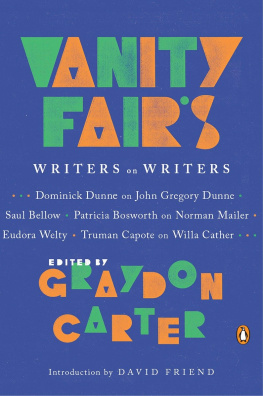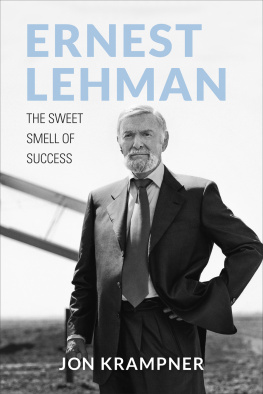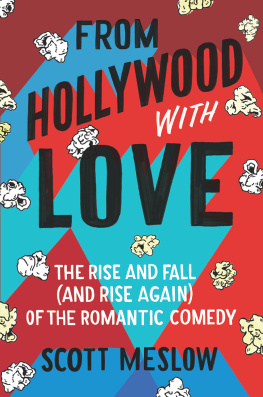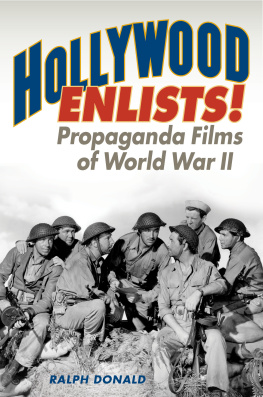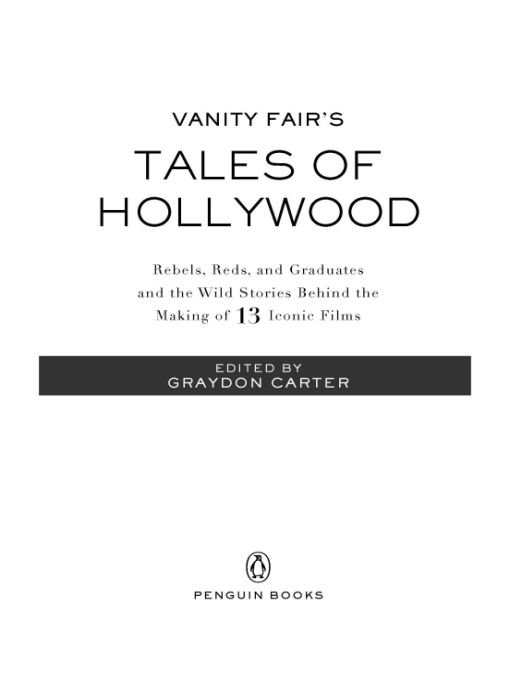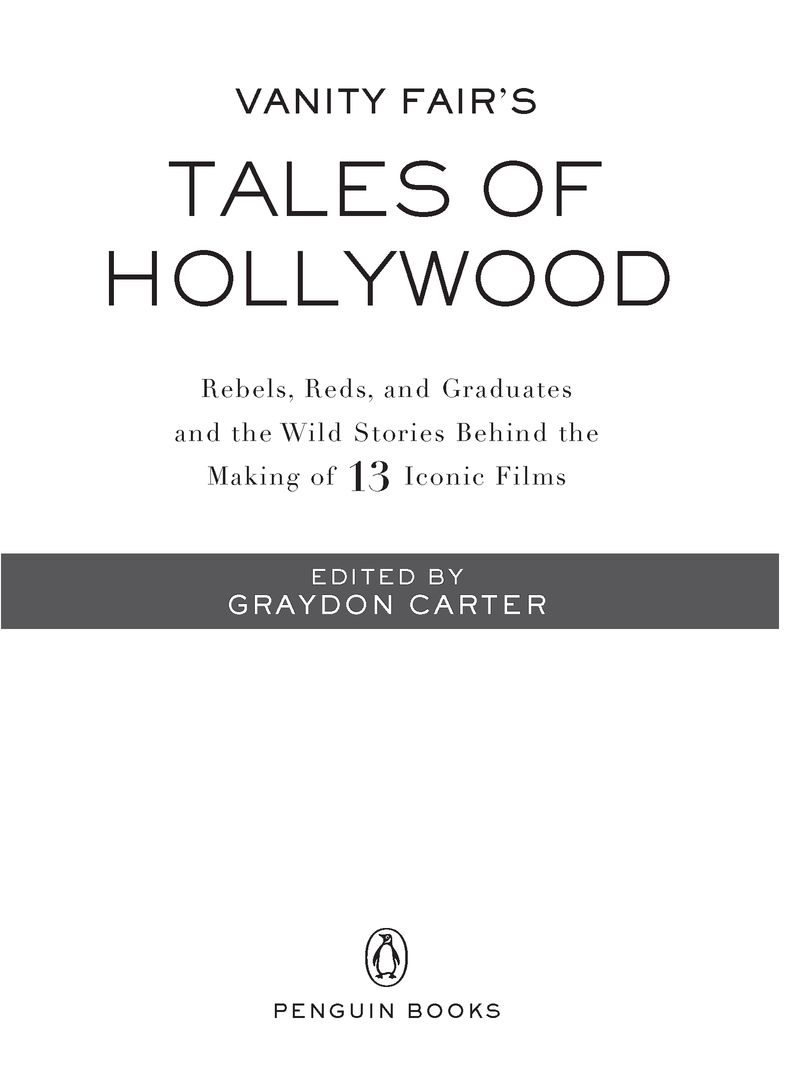Table of Contents
PENGUIN BOOKS
VANITY FAIRS TALES OF HOLLYWOOD
GRAYDON CARTER has been the editor of Vanity Fair since 1992. He is the author of Vanity Fairs Hollywood (Viking Studio, 2000), Oscar Night (Knopf, 2004), Vanity Fair: The Portraits (Abrams, 2008), and What Weve Lost: How the Bush Administration Has Curtailed Our Freedoms, Mortgaged Our Economy, Ravaged Our Environment, and Damaged Our Standing in the World (Farrar, Straus and Giroux, 2004). Carter served as producer of the films The Kid Stays in the Picture, Chicago 10, Surfwise, and Gonzo, and has won Emmy and Peabody awards as executive producer of the CBS documentary 9/11, which aired in 140 countries. Carter, a former writer at Time and Life, co-founded Spy magazine and served as the editor of The New York Observer. He is also an owner of the Waverly Inn, a restaurant in New York Citys West Village.
INTRODUCTION
The Making Of...
Put simply, it is the journalists job to tell the story behind the story. In the case of governments or large corporations, the odds are that whatever line theyre peddling, it may look like the truth, smell like the truth, and be labeled as the truth, but its most certainly anything but the truth. It falls therefore to the journalist to peel away the layers of artifice and avarice, much like one does the leaves of an artichoke, to get to the heart of the matter. Its no accident that both the White House and Wall Street like to release bad news on Fridaystheir assumption being that the reading public will skip past the reports of their misdeeds as they skim their Saturday papers before heading off to the mall, a soccer game, or, perhaps, a movie.
Hollywood also likes to release its offerings on Fridays, turds and gems alike. The official story they put forward is the one you can see up there on the screen for yourself. It then becomes a meal for pygmiesthe sorry lot otherwise known as film critics. The fun part, and here is where the journalist comes in, is telling the story of how that entertainment was conceived, how it was assembled, and generally who did what to whom. The Making of... , in other words. These are the unreported anecdotes, the filmgoers equivalent of liner notes, and theyre often more interesting than the movies themselves. Who did the director really want for the lead? Which two (or three) stars were spotted carrying on in the location trailer? Who doesnt want to know about the knockdowns, the hissy fits, the brawls, and the breakdowns?
In this volume, Vanity Fairs Tales of Hollywood, our writers report not only on what almost happened but also on what really happened on the locations and back lots of 13 of the most iconic films and classic flops in cinema history. Vanity Fair didnt create the Making of... genre, but our stable of writers is uniquely qualified to tell these stories, having earned their commissions reporting on the old studio system, the Lew Wasserman era, and the brackish tide pool that is todays Hollywood.
A big part of this books template is the What if... ? What if Springtime for Hitler, a novel that a young television sketch-comedy writer named Mel Brooks planned to write, had ended up as just another paperback sitting on a shelf at the Strand, rather than as the creative nub that spawned The Producers? What if Warren Beatty, the director of Reds, hadnt been able to wrangle his fellow rake Jack Nicholson into the role of Eugene ONeill by asking him to suggest which Hollywood leading man could out-Beatty Beatty for Diane Keaton? (Nicholson could think of only oneand he was magnificent in the part.) And what if Warner Bros. had decided to protect its newly minted star, 24-year-old James Dean, and refused to let him appear in Nicholas Rays electric teen opera, Rebel Without a Cause? Finally, what if the late New York magazine editor Clay Felker, unimpressed by a piece on outer-borough clubgoers, had killed Nik Cohns story Tribal Rites of the New Saturday Night, which eventually became Saturday Night Fever, the movie that brought white polyester suits into the 70s mainstreamor, more accurately, got blamed for bringing them into the mainstream? Not incidentally, two other films in this collection were also inspired by magazine articlesa 1946 Cosmopolitan piece called The Wisdom of Eve provided the basis for All About Eve, and a 1948 Colliers story, written by Ernest Lehman, called Hunsecker Fights the World, grew into Sweet Smell of Success.
For sheer delight, dip into David Kamps When Liz Met Dick, about the making of Cleopatra, the four-hour 1963 epic that still takes the honors for being the most expensive movie ever made. It cost a then record $44 million (more than $300 million in current dollars). Joseph Mankiewicz, the director who completed the film, called it the toughest three pictures I ever made. It took two of everything to get Cleopatra in the can: two Twentieth Century Fox studio regimes, two directors (the first was Rouben Mamoulian), and more than two years of shooting. As if that were not enough, Cleopatra also had the two biggest stars in the world, Elizabeth Taylor and Richard Burton, engaged in a riotously public adulterous affair that resulted in condemnation not only on the Senate floor but in the fragrant pages of the Vatican newspaper. As Burton said of sleeping with Taylorand this is one of my favorite linesIts like fucking Khrushchev! Ive had affairs beforehow did I know the woman was so fucking famous!
Cleopatra was initially considered a flop. As was Alexander MacKendricks noir-ish cocktail, Sweet Smell of Success. It was among the first screenplays by Lehman, a former press agent, who went on to become arguably the greatest screenwriter of all time, putting notches in his belt for films as varied as The Sound of Music, North by Northwest, West Side Story, The King and I, Whos Afraid of Virginia Woolf?, Hello, Dolly!, and Sabrina. Sweet Smell of Success, so dangerous at the time, so written off by critics and audiences alike, so deliciously and unrelentingly dark, is now considered by The New Yorkers David Denby, among others, as being the finest New York film ever made. Indeed, as Sam Kashner writes, Sweet Smell of Success did for New York what Billy Wilders Sunset Boulevard had done for Los Angeles. That its central character, an unsavory gossip named J. J. Hunsecker, was based on Walter Winchellat midcentury, Americas most powerful syndicated columnistmade it all the more daring an enterprise. What makes it shine, aside from the brilliant performances of Burt Lancaster, as Hunsecker, and Tony Curtis, as the feral press agent Sidney Falco, is the crispness of the dialogue, a collaboration between Lehman and Clifford Odets, then at his most bitter heights of ennui and disaffection.
And then theres Kashners Heres to You, Mr. Nichols, about Mike Nicholss 1967 screen adaptation of Charles Webbs relatively uncelebrated novel The Graduate. (Kashner is a protean The Making of... hand. Five of the pieces presented here are his.) The Graduate was set to star Robert Redford and Candice Bergen. The rapacious Mrs. Robinson, who seems to burst from the pages of Flaubert, was initially set aside for Ava Gardner, and Gene Hackman had signed on to play her husband. That Nichols eventually chose a completely different cast, including a young, insecure Off Broadway actor named Dustin Hoffman for the part of Benjamin Braddockand that Nicholss brother happened to send him a new LP, Simon and Garfunkels


